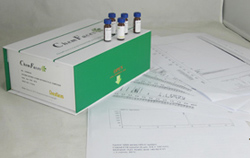Hot Products



| Catalog No. | Information |
| CFN98903 | Aristolactam BII Aristolactam BII exhibits antimicrobial and antiinflammatory activity, it shows significant activity towards DPPH radical scavenging and potent inhibitory effects against tyrosinase mushroom. Aristolactam BII also exerts its significant neuroprotective effects on glutamate-injured primary cultures of rat cortical cells by directly inhibiting the production of nitric oxide. |
| CFN98904 | Aristolactam BIII Aristolactam BIII possesses anti-platelet aggregation activity in vitro, it also shows significant cytotoxic activity (IC50 values < 4 microg/mL) against P-388, HT-29 and A549 cell lines in vitro. |
| CFN99222 | Aristolactam FI Aristolactam FI shows platelet aggregation inhibitory activity.It is a potential cancer chemotherapeutic and chemopreventive agent. |
| CFN99505 | Aristolochic acid A Aristolochic acid A is a potent nephrotoxin, which strongly induced toxic damage during ovarian maturation by inhibiting Akt phosphorylation-mediated suppression of apoptosis. |
| CFN99506 | Aristolochic acid B Aristolochic acid II (Aristolochic acid B,AAII), one of the major components of the carcinogenic plant extract aristolochic acid, is known to be mutagenic and to form DNA adducts in vitro and in vivo, AAII shows more carcinogenic risk than aristolochic acid I, and this may be, at least partly, the result of its increased levels in kidney and plasma. |
| CFN90516 | Aristolochic acid C Aristolochic acid C could as the larval feeding stimulants. |
| CFN90783 | Aristolochic acid D Chinese-herb nephropathy (CHN) is a rapidly progressive renal fibrosis associated with the intake of a Chinese herb (Aristolochia fangchi) containing nephrotoxic and carcinogenic aristolochic acids. |
| CFN90312 | Aristololactam I Aristololactam I (AL-I), the main metabolite of aristolochic acid I (AA-I), it can lead to renal damage, the cytotoxic potency of Aristololactam I is higher than that of AA-I and that the cytotoxic effects of these molecules are mediated through the induction of apoptosis in a caspase 3-dependent pathway. |
| CFN96139 | Aristolone Aristolone is a natural product from the leaf oil of Alpinia polyantha. |
| CFN91151 | Arjunetin Arjunetin, an insect feeding-deterrent and growth inhibitor, shows antioxidant and anti-inflammatory activities. It demonstrates significant inhibition of(Dipeptidyl peptidase-IV) DPP-IV enzyme, the DPP-IV Inhibitory activity translated into significant cardioprotective effects in the setting of diabetes. |